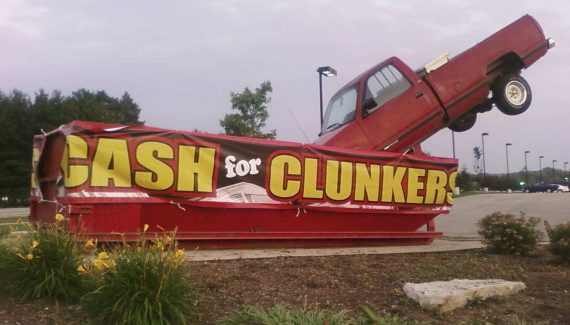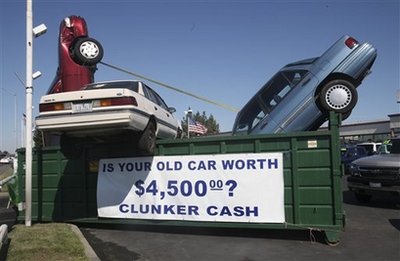Cash For Clunkers Was A Boondoggle From The Start
It was clear from the start that "Cash For Clunkers" was a bad idea.
Steve Verdon’s post this afternoon about a new study of the impact of the much-vaunted “Cash for Clunkers” program reminded me of the fact that, back when this program was still in effect, and just after it ended, it was already pretty evidence that the program didn’t accomplish the goals it supposedly had, and that instead of stimulating auto sales, it mostly caused people who were already going to buy a car to do so before the program expired so they could get the government rebate. In other words, it was clear from the state that this program was a failure.
In the beginning, it seemed like the program was a huge success as this July 2009 Washington Post report demonstrates:
The government’s “cash for clunkers” program, aimed at boosting stagnant auto sales, is almost out of money, putting its future in question, according to sources familiar with the effort.
Passed by Congress in late June to help the flagging U.S. auto industry and launched just a week ago, the $1 billion program gives vouchers worth up to $4,500 to consumers who trade in gas-guzzling cars for more fuel-efficient models. The highly publicized effort was scheduled to run until Nov. 1, or until money ran out. It was not expected to run out of cash so quickly.
The effort, formally known as the Car Allowance Rebate System, or CARS, appeared headed for a temporary shutdown at midnight Thursday. Federal transportation officials became increasingly concerned that the program’s popularity with consumers could drain its budget by week’s end, according to sources familiar with the discussions who spoke on the condition of anonymity.
As it turned out, though, what was happening was that people were cashing in on the rebate by cutting back their spending in other areas. In July 2009, for example, overall retail sales actually fell even though automobile sales increased, a strong indication that Cash for Clunkers was doing nothing to stimulate the economy at the time. Auto sales were up for both July and August 2009, but when the program ended at the end of September, they fell like a rock:
DETROIT — After two frenzied months during the government’s cash-for-clunkers program, new-vehicle sales in the United States fell in September back to the levels seen earlier this year, automakers said Thursday.
General Motors said it sales declined 45 percent, and Chrysler reported a 42 percent drop from September a year ago.
Sales were down 20 percent at Honda, 13 percent at Toyota and 7 percent at Nissan.
“Floor traffic was lousy all month,” Mark LaNeve, G.M.’s vice president for United States sales, said. “Every brand, every region of the country. It was a real post-clunker hangover. It was disappointing. I expected the month to be a bit stronger, but it just wasn’t.”
The Ford Motor Company said its sales declined 5 percent from September 2008. For the entire third quarter, though, sales by Ford’s three domestic brands rose 5 percent, marking its first quarterly increase in four years.
Ford said sales of its F-series pickup truck rose for the second consecutive month, a positive indication about the housing market and broader economy, as the F-series is frequently purchased by building contractors and other businesses.
The best news for the month came from Hyundai, which has been gaining momentum throughout the recession. Hyundai said its sales rose 27 percent in September.
Total industry sales are expected to be 23 percent less than a year ago, according to a forecast by the Web site Edmunds.com.
In the months that followed, several studies of the impact of the program came out, and the evidence was pretty clear that the program was a boondoggle. Even while the program was still in effect, a study by the well-respected industry analysts at Edmunds found that all the program was doing was causing purchasing decisions to be time shifted in response to the subsidy:
According to Edmunds, about 200,000 old low mileage cars would normally be traded in, every 3 months, in exchange for more efficient higher mileage cars, without this program.
The highest rebate is $4,500, and the lowest is $3,500. If everyone qualified for $4,500 per vehicle, about 222,000 vehicles would have just taken advantage of the government’s money. At $3,500, 286,000 vehicles will have been sold.
I assume that, given all the raving, the government will eventually get around to assigning more money. It will take at least 2 or 3 months for the legislation to work its way through Congress. Meanwhile, if all buyers have qualified for the higher $4,500 rebate, the “cash for clunkers” program will mean a marginal increase in car sales of 22,000 this quarter. $1 billion divided by 22,000 means a net cost to the government of $45,354 per car.
If all buyers only qualify for the $3,500 rebate, it means a marginal increase in sales of about 86,000, or a net cost to the taxpayers of $11,628 per vehicle. In all likelihood, however, there will probably be a mix of vehicles qualifying for various rebates between $3,500 and $4,500. Based upon that assumption, Edmunds.com estimates that the average cost to the taxpayer will be about $20,000 per vehicle.
Further details can be found at the Edmunds study mentioned in the article.
Even most of the marginally extra sales really represent people who were going to buy a new car eventually anyway. They are just buying a bit sooner than they expected. Old clunkers don’t last forever, and they are almost all eventually replaced. The government is shifting tomorrow’s demand to today, stealing from tomorrow to pay for today, but at great cost to the taxpayer.
By October, it was clear that the program had not achieved either of its objectives:
Cash for clunkers had two objectives: help the environment by increasing fuel efficiency, and boost car sales to help Detroit and the economy. It achieved neither. According to Hudson Institute economist Irwin Stelzer, at best “the reduction in gasoline consumption will cut our oil consumption by 0.2 percent per year, or less than a single day’s gasoline use.” Burton Abrams and George Parsons of the University of Delaware added up the total benefits from reduced gas consumption, environmental improvements and the benefit to car buyers and companies, minus the overall cost of cash for clunkers, and found a net cost of roughly $2,000 per vehicle. Rather than stimulating the economy, the program made the nation as a whole $1.4 billion poorer.
The basic fallacy of cash for clunkers is that you can somehow create wealth by destroying existing assets that are still productive, in this case cars that still work. Under the program, auto dealers were required to destroy the car engines of trade-ins with a sodium silicate solution, then smash them and send them to the junk yard. As the journalist Henry Hazlitt wrote in his classic, “Economics in One Lesson,” you can’t raise living standards by breaking windows so some people can get jobs repairing them.
In the category of all-time dumb ideas, cash for clunkers rivals the New Deal brainstorm to slaughter pigs to raise pork prices. The people who really belong in the junk yard are the wizards in Washington who peddled this economic malarkey.
Later on we learned that the actual cost of the program to taxpayers came out to something closer to $24,00 per vehicle, and that it had the unintended consequence of harming charities who accept donations of used vehicles as a fundraising method, and people who actually wanted to buy used cars.
Sure, the program temporarily stimulated car sales, but it’s pretty clear that all it really did was give consumers the incentive to purchase a new car earlier than they might have been planning. We saw a similar impact on housing prices from the New Home Buyer Tax Credit that was in effect at roughly the same time; home sales went up while the credit was in effect, then dropped like a stone as soon as it wasn’t. That’s not economic stimulus, it’s a time-shifted purchase, and as we saw from the retail sales numbers noted above, it had a negative impact on consumer spending in other parts of the economy. What was wrong with “Cash for Clunkers” isn’t that they ran out of money — although that certainly should cause people to doubt the government’s ability to make economic forecasts of any kind — or that it wasn’t in effect long enough, but that it was a fundamentally flawed program to begin with. The study that has come out now really shouldn’t surprised anyone..






I too immediately think about the homebuyer credit as a comparison. Except that was simply shifting – there was no destruction of old houses so we could buy new ones.
Ultimately I’m amused by so-called republicans and libetarian dreamers who bring nothing to the economic discourse, but tax cuts for the rich and growth through austerity, belittling any productive effort they can.
The auto industry and the couple of million jobs it represents was on the brink. Now it is not. C4C had a role in that. Not a big one…but a role none-the-less. So-called republicans and libertarians wanted to just slash those couple million jobs on top of the 600,000 jobs we were losing per month at the end of Bushes Presidential Appointment. Which is, of course, completely in sync with their efforts to hold back the economy for pure political gain.
This is a silly thing to say. Exactly how was a $1 billion program supposed to make up for a $1.2 trillion hole in consumer spending? A $1 billion stimulus program will make up for $1 billion in lost spending and no more.
@Ben Wolf: Multipliers, Ben, multipliers. Check an ECO101 text.
@John Burgess: Multipliers are assumed for banking, not consumer sales. Takes real gall to tell someone to read a book you’ve never even seen.
When someone talks about time shifting as though it’s meaningless, they’re demonstrating they don’t know how an economy actually works. Any real businessman will tell you that making a sale today can oftentimes be much better than making the same sale 6 months from now. Sometimes that immediate sale is better than an infinite number of sales 6 months from now because if you don’t sell something today, you won’t be around in 6 months.
Mike
@John Burgess: The money multiplier is a neo-liberal invention which claims the following: banks leverage each dollar of reserves in order to increase their economic effectiveness by making loans. Hence we got a Federal Reserve which pumped bank reserves up by 2,100% since 2007 in the hopes of stimulating lending.
Unfortunately, observation of reality shows us the money multiplier is a myth: bank lending continues to be flat because banks do not lend their reserves. Your Econ 101 text is fundamentally flawed because it doesn’t understand the banking system. Nor is there any supposed money multiplier for consumer spending, despite your assertion it exists.
@Ben Wolf:
Ben,
Can you stop it with the goal post moving thing? I wasn’t arguing and I don’t thing Doug is arguing that because cash for clunkers didn’t end the recession right away it was a failure.
I was arguing it was a failure because an analysis indicates it did nothing over a 6 month span to increase car sales. It increased them for 2 months, then for the next 3 reduced them, so in the end there was no stimulus effect…due to cash for clunkers.
This is not an indictment on stimulus spending as a whole, although it could be part of a broader indictment. It is merely an indictment on the program cash for clunkers. So your attempts at goal post moving are noted, but they are stupid. Please, try a valid argument next time.
Also Ben regarding fiscal multipliers maybe you shouldn’t be so quick to tell others that such things don’t exist in economic theory. This was one of the big reasons for the stimulus bill that Obama proposed and Congress passed early on in his term.
Now the efficacy of such multipliers is hotly debated, but to assert that your personal views are the only views to be found in an economics textbook is a nice display of hubris.
@MBunge:
If you are in that kind of a bind-i.e. you must make a sale today or be bankrupt in 6 months you are pretty much dead anyways. See, if you move all your sales from December to July so you can stay open December what are you going to do in December when you have zero sales? Go bankrupt of course. You might consider this good economic policy, but I call it wishful thinking and is basically a variant of what has gotten us into this mess to begin with. Especially when you consider that these kinds of programs are wealth transfers from taxpayers to car buyers and the auto industry.
@Steve Verdon:
In other words you didn’t read Doug’s post or my previous comment. Per Doug:
So yes, he specifically stated Cash-for-Clunkers didn’t stimulate the economy. And it’s the same argument you made in your post, you just didn’t make it explicit because you’re brighter than Doug.
@Ben Wolf:
Yes, and it didn’t? Car sales over a six month period were pretty much what there were expected to be despite the program. So the program was a failure from an economic stimulus program perspective.
Now your argument is that of course it wasn’t going to stimulate the economy because it was so small. But that wasn’t our argument. Even a small program can have stimulative effects. For example, food stamps has an estimated fiscal multiplier of 1.73. Expanding that program during a severe recession would likely have stimulative effects. However that program can only be expanded to a certain point. That is we can’t expand the program to half $500 billion annually and expect GDP to go up by $850 billion.
In other words our argument is that, even though the program was small it had no stimulative effects, small or large. In fact, given the cost of debt it may have a negative impact.
@Steve Verdon: Of course the program didn’t provide stimulus: it was too damned small to make a dent in aggregate demand. Nor did Doug make an argument regarding stimulus for the auto sector. His argument was quite clearly that the program failed to provide stimulus in aggregate, though if you want to suggest Doug doesn’t understand what the aggregate is I can accept that.
Meaning that sales increased for the duration of the program. He does it again here, because Doug doesn’t understand flows as opposed to stocks. You do. That’s why I get so mad at you, becaus you choose to use your powers for evil instead of for good. Come to the light, Steve!
@Ben Wolf:
I’m not talking aggregate demand. FFS.
I’m talking about the auto industry alone. Looking at the data it appears to have done damn little for the auto-industry.
Now, if it does stimulate the auto industry and since the auto industry is part of the economy, it would provide a stimulus, albeit a small one, to the economy as a whole (a reasonable inference). But since it is small you’d be foolish to look for the effect by analyzing aggregate demand…so you look at the auto industry. No stimulus there, then probably no stimulus for the economy as a whole either (another reasonable inference).
You don’t know what you are talking about. If the sales were expected, for the year to be say 3.6 million cars sold absent cash for clunkers, and with cash for clunkers 3.6 million are sold for the year, then that is a pretty good indicator that the program was a bust.
See, what Doug said is true. Sales went up, then they went down. The overall effect over a longer time period is no new car sales were made. To make a “new” car sale the program would have to induce people to make car purchases a few years ahead of schedule, not just a few months.
Why you are going on about stocks and flows is beyond me. Yes, I know that stocks and flows are not comparable, but looking at the sale of cars for July and August (a flow) vs. the sale of cars in September onwards (a flow) is valid. You can compare flows.
@Hey Norm: Because the only proper role of government is to torture brown people. And maybe build highways. Anything else is unconstitutional.
That’s exactly the point, Steve. When the flows dried up the economic activity dried up. While the flows were active economic activity increased. Stimulus works, but stimulating one industry for two months will not provide a sustained recovery unless the economy in aggregate is stimulated. The program worked for as long as it lasted and it increased revenues for the auto industry for as long as it lasted.
And once again, Doug’s argument was that a $1 billion program didn’t stimulate the economy as a whole. He explicitly stated this and everyone is free to read it for themselves. You’re bordering on McCardle defender territory with this “What he really meant to say was . . .” line you keep running.
A great picture accompanying this thread, graphically depicting the program’s worth.
See Steve, opposing Obama and Keynesian stimulus is evil. Not right, not wrong, but evil.
It’s funny to watch how wingnuts convince themselves that their political beliefs are actually facts.
@Ben Wolf:
Oh, I see what you are getting at. It increased the flows during the time the program was in effect therefore a success.
Bollocks.
Sure, the flow increased, by decreasing the future flow. There was no net gain (or so the data suggest). That is my definition of success for a stimulus program…big or small. Food stamps is a program where you’d get a net gain. Cash for clunkers? No. As such it was a policy failure.
I really don’t understand the time shifting criticism. That’s sort of the point of stimulus, you build a bridge now because you were going to build the damn thing anyways. And you gain more out of building it during a recession because the cost to borrow is going to be cheaper and you’re getting employment up. The fact that you were going to do it anyways is PLUS, not a negative.
In the case of the cars, how does it help a car company to expect a sale in a year after the recession is over when people have money? Seriously who the hell does that help? The time shifting of the sale IS THE ENTIRE POINT.
In the long run we’re all dead… some lessons are just lost on people.
After their ideology took a big beating in the voting booth yesterday, the wingnuts are looking for something…anything to re-inflate their hot air filled Hindenburg of a belief system.
Are you ready for Cash for Clunkers II? The EPA is funding plans to get older heavy-duty commercial trucks in pollution areas off the roads, at a cost up to $30K/truck.
In the category of stuff I couldn’t make up. This snake won’t die.
@Richard Gardner:
You say that like it’s a bad thing.
@Steve Verdon: Sure, the flow increased, by decreasing the future flow.
Gote my html quotes backward in the last post, FYI.
@ Console…
Of course you are correct…and the White House states in the first paragraph of their webpage regarding C4C that the whole point was time-shifting…or countercylical fiscal policy. And in fact the sales were pulled forward from a longer time-frame than the Edmunds report claims.
Again…what you are seeing is a bunch of people, whose only contribution to the economic discourse is slashing taxes for the rich and slashing middle-class jobs through shrinking government, nit-picking whatever they can find to nit-pick.
@Console:
Console,
Sure the idea is to time shift, but also to get sustained growth. Think of it this way, the idea is that we’ll “borrow from the future” to fund spending today to end the recession, right? Okay, so here is a simple example of the logic at work.
Case 1 With no Stimulus:
GDP: 100
Growth rate: 0% for 3 periods, then 3%.
Case 2 With Stimulus:
GDP: 100
Growth rate: 2% for 3 periods, then 3%.
After 15 periods where are we?
Case 1 GDP: 142.6
Case 2 GDP: 151.3
Now if your borrowing cost is less than 8.7 (difference between Case 1 and 2) then the fiscal stimulus was a good thing. If not then it wasn’t.
In this case the time shifting works. In the cash for clunkers case it doesn’t because at the end of the time span the net gain is zero. You’d exactly the same outcome doing nothing and not incurring the borrowing costs.
You’d look less foolish to those who have read that passage if you stopped using that quote that way.
@Ben Wolf:
Ben,
You’d impress me a heck of alot more if you stopped with the mind reading schtick. It is stupid and offensive.
I read nothing from Edmunds, I read the resources for the future study.
@Hey Norm:
Norm,
Where the f*ck have I called for tax cuts?
Oh, nowhere.
Moron.
If you go out of business a 3 percent GDP growth rate next year does you no good. You can look at it overall, but cash for clunkers exists as it did because it also targeted a particular industry.
Ah, so you chose to willingly embrace fraudulent conclusions. Gotcha.